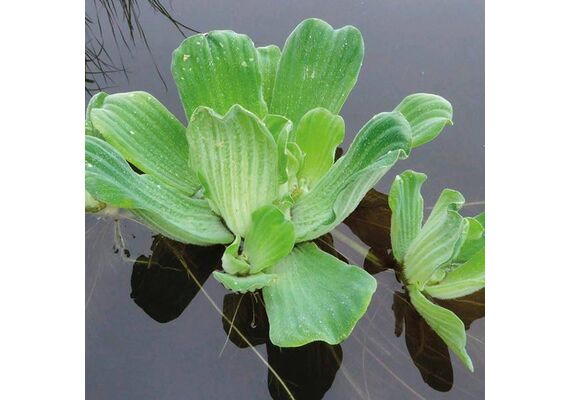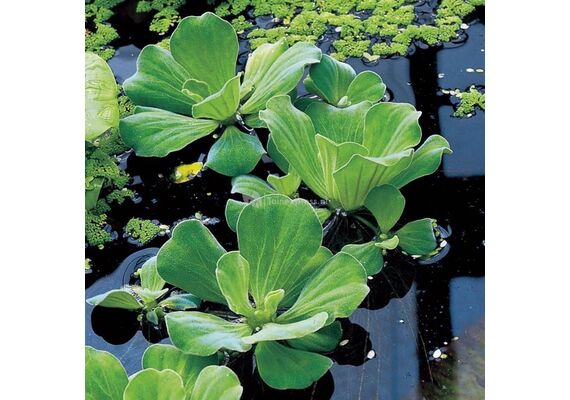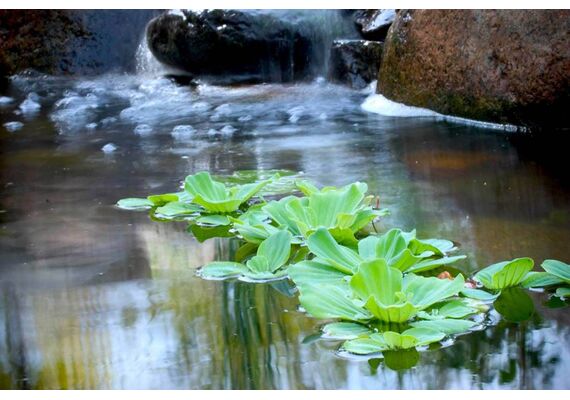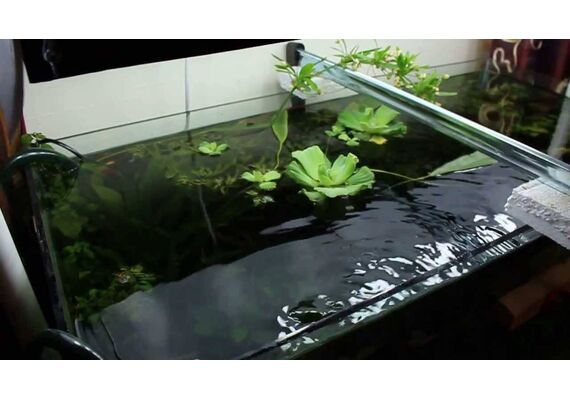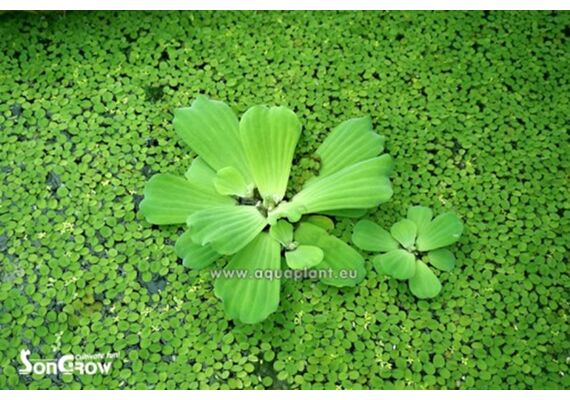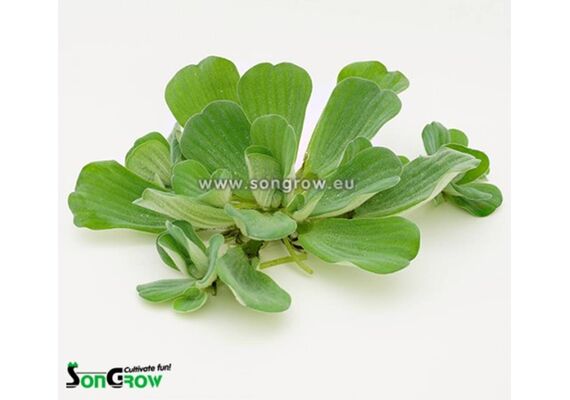EAN barcode: 8718076004777
"Ένα stratiotes pistia στο κατάστημα είναι συχνά πολύ μεγάλο για ένα ενυδρείο αλλά πολύ κατάλληλο για μια λίμνη.
Αυτό το φυτό παράγει πολύ φυτά μωρών πολύ γρήγορα και αποσπάνοντας τα μικρά φυτά από τη μητέρα μπορείτε να τα κάνετε κατάλληλα για ένα ενυδρείο.
Οι υπέροχες ρέουσες ρίζες είναι ένα όμορφο θέαμα και πάρα πολλά φυτά απομακρύνονται εύκολα από την επιφάνεια του νερού.
"Ένα stratiotes pistia στο κατάστημα είναι συχνά πολύ μεγάλο για ένα ενυδρείο αλλά πολύ κατάλληλο για μια λίμνη.
Αυτό το φυτό παράγει πολύ φυτά μωρών πολύ γρήγορα και αποσπάνοντας τα μικρά φυτά από τη μητέρα μπορείτε να τα κάνετε κατάλληλα για ένα ενυδρείο.
Οι υπέροχες ρέουσες ρίζες είναι ένα όμορφο θέαμα και πάρα πολλά φυτά απομακρύνονται εύκολα από την επιφάνεια του νερού.
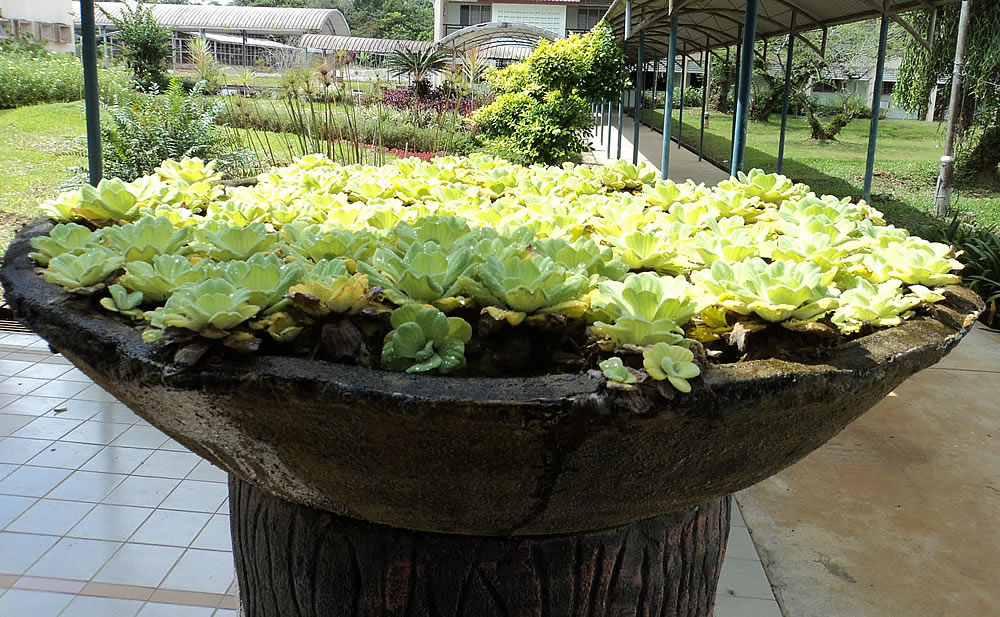

Όπως υποδηλώνει και το όνομά του, το μαρούλι μοιάζει με ένα πλωτό ανοικτό κεφάλι μαρούλι. Το μαρούλι έχει πολύ πυκνά φύλλα. Τα φύλλα είναι ελαφρώς θαμπό πράσινα, είναι τριχωτά και έχουν ράβδο. Δεν υπάρχουν στελέχη φύλλων. Οι ρίζες μαρούλι νερού είναι ανοιχτόχρωμες και φτερωτές. Τα λουλούδια του είναι αφανή.
Συνήθεια
το μαρούλι είναι ένα πλωτό πολυετές
κυμαινόμενο, "υποχρεωτικό" (που απαιτεί υγρό βιότοπο)
τα συνδεδεμένα φυτά σχηματίζουν πυκνά χαλιά στο νερό
θα σταματήσει την κυκλοφορία πλοίων σε ποτάμια · θα καλύψει μια επιφάνεια της λίμνης από την ακτή στην ακτή
Βιότοπο
ένα υδάτινο ζιζάνιο παγκοσμίως σε ποτάμια, λίμνες και λίμνες εύκρατου κλίματος
ανοχή θερμοκρασίας: το μαρούλι δεν είναι χειμωνιάτικο. η ελάχιστη θερμοκρασία ανάπτυξης είναι 15o C (59o F). η βέλτιστη θερμοκρασία ανάπτυξης είναι 22-30o C (72-86ο F). η μέγιστη θερμοκρασία ανάπτυξης είναι 35o C (95o F) (Kasselmann 1995)
Pistia stratiotes L.
Αρχική περιγραφή:
μονόκοκκο, πολυετές
ελεύθερη-επιπλέουν εκτός από όταν λανθάνονταν στη λάσπη? μεμονωμένα ή μαζικά σε μεγάλους αριθμούς. τα μητρικά και θυγατρικά φυτά που συνδέονται με τους κοντόχονδρους
Τα παχιά μαλακά φύλλα σχηματίζονται σε ροζέτες, χωρίς στελέχη φύλλων. αφήνει σε μήκος 6 ιντσών. ανοιχτό πράσινο; με παράλληλες ράχες (φλέβες), καλυμμένες σε κοντές τρίχες. τα περιθώρια των φύλλων κυματιστά, τα κορυφαία περιθώρια
λουλούδια (δεν παρατηρήθηκαν στη Φλώριδα μέχρι τη δεκαετία του '80 αν και είχαν ανθίσει σε όλο το μήκος)? σχεδόν κρυμμένο στο κέντρο μεταξύ των φύλλων? σε μικρό μίσχο, μεμονωμένο θηλυκό λουλούδι κάτω και κορμό αρσενικών λουλουδιών πάνω
ρίζες κρέμονται υποβιβασμένες κάτω από τα πλωτά φύλλα? φτερωτός, πολυάριθμος
φρούτα ένα πράσινο μούρο
Τα στρουθοειδή της Pistia δεν είναι πιθανό να συγχέονται με οποιαδήποτε άλλη πλωτή εγκατάσταση.

Προέλευση
Οι εμπειρογνώμονες διαφωνούν ως προς το κατά πόσον τα στίγματα των Πίστων είναι ή όχι εγγενή στις ΗΠΑ. Σε τελευταία ανάλυση, παρατηρήθηκε, περιγράφηκε και σχεδιάστηκε από τον William Bartram το 1765 κατά τη διάρκεια των εξερευνήσεών του στη Φλώριδα. Έγραψε ότι είδε:
"... τεράστιες ποσότητες των ψίθυρων, οι οποίες αναπτύσσονται σε πολύ μεγάλο μέρος του δρόμου [κατά μήκος του ποταμού St. Johns, Florida], και συνεχώς κατεβαίνουν με το ρεύμα, και μεγάλα quanitites κατατεθεί σε όλη την εκτεταμένη ακτές αυτού του μεγάλου ποταμού και τα νησιά του, όπου είναι μπλεγμένος ... και ... όλα γεμισμένα μαζί με τέτοιο τρόπο ώστε να σταματήσουν το στόμα ενός μεγάλου κολπίσκου, έτσι ώστε ένα σκάφος δύσκολα μπορεί να ωθηθεί μέσα από αυτά, αν και σε 4 πόδiα νερό ... "
Μερικοί ειδικοί πιστεύουν ότι η προέλευση του φυτού είναι στην Αφρική.
Κατανομή στις ΗΠΑ
Το μαρούλι είναι παρόν στις πολιτείες των νοτιοανατολικών ΗΠΑ και βόρεια του Νιου Τζέρσεϋ και της Νέας Υόρκης και δυτικά προς το Τέξας, την Αριζόνα και την Καλιφόρνια. Επίσης στη Χαβάη, το Πουέρτο Ρίκο και τις Παρθένες Νήσους.
Ο καλύτερος τρόπος για να εντοπίσετε την εξάπλωση των επεμβατικών υδρόβιων φυτών μπορεί να είναι να προσδιορίσετε τις λεκάνες απορροής (λεκάνες απορροής) στις οποίες έχουν ανακαλυφθεί. Οι χάρτες αποστράγγισης δίνουν χρήσιμες πληροφορίες στους οικολογικούς διαχειριστές, επειδή οι χάρτες αποστράγγισης δείχνουν επακριβώς το πού βρίσκονται τα φυτά, διευκολύνοντας οι διαχειριστές να καταλήξουν στο συμπέρασμα σχετικά με το πού μπορούν να ακολουθήσουν τα φυτά και, συνεπώς, πού να λάβουν προληπτικά μέτρα

Πώς φτάσαμε εδώ
Τα στρουθοειδή Pistia, μαρούλι, πιστεύεται ότι κάποιοι είναι φυσικό φυτό και ότι άλλοι είναι ένα μη αυτόχθονο φυτό που έφτασε στο πηνίο των ιστιοπλοϊκών πλοίων του εξερευνητή.
Τα στρείδια της Πίστας συνεχίζουν να πωλούνται μέσω εμπόρων προσφοράς ενυδρείων. δεν ανήκει στην Αμερικανική Ομοσπονδιακή Ζώνη Ζιζανίων.
Δυνατότητα διάδοσης αλλού στις ΗΠΑ
Το θαλάσσιο μαρούλι βρίσκεται παγκοσμίως στους τροπικούς και τους υποτροπικούς, αλλά η εξάπλωσή του περιορίζεται από το σοβαρό κρύο (Holm et al., 1977). τα φύλλα του αναβιώνουν μετά από μέτρια παγώνει
Το μαρούλι του νερού αναπαράγει φυτικά και σεξουαλικά. νέα κόρη φυτά σχηματίζονται σε stolons που μεγαλώνουν από τα μητρικά φυτά? τα σπορόφυτα παράγονται σε ήπια κλίματα (Penfound & Earle 1948)

Προβλήματα / Εφέ
Η Pistia stratiotes χαλάσματα φράζουν τις οδούς, καθιστώντας αβέβαιη τη ναυσιπλοΐα, την αλιεία και σχεδόν όλες τις άλλες δραστηριότητες νερού
τα υφάσματα μαρούλι υδάτων υποβαθμίζουν την ποιότητα του νερού εμποδίζοντας τη διασύνδεση αέρα-νερού και μειώνοντας σημαντικά τα επίπεδα οξυγόνου στο νερό, εξαλείφοντας τα υποβρύχια ζώα όπως τα ψάρια

τα χαλιά μαρούλι μειώνουν σημαντικά τη βιολογική ποικιλότητα: τα χαλάκια εξαλείφουν τα εγχώρια βυθισμένα φυτά παρεμποδίζοντας το φως του ήλιου, αλλάζοντας τις ερημωμένες φυτικές κοινότητες, πιέζοντας μακριά και συνθλίβοντας τους, αλλάζοντας επίσης τις ζωικές κοινότητες αποκλείοντας την πρόσβαση στο νερό ή / και εξαλείφοντας τα φυτά που τα ζώα εξαρτώνται από το καταφύγιο και φωλιάζουν
στη Φλώριδα, το μαρούλι δεν υπήρξε ποτέ το πρόβλημα που έχει η υάκινθος του νερού. το μαρούλι είναι ουσιαστικά υπό τον "έλεγχο συντήρησης" στη Φλώριδα.

EAN barcode : 8718076004777
"A pistia stratiotes in the shop is often too big for an aquarium but very suitable for a pond.
This plant produces many baby plants very quickly and by detaching the small plants from the mother you can make them suitable for an aquarium.
The lovely hanging roots are a beautiful sight and too many plants are easily removed from the water surface."
"A pistia stratiotes in the shop is often too big for an aquarium but very suitable for a pond.
This plant produces many baby plants very quickly and by detaching the small plants from the mother you can make them suitable for an aquarium.
The lovely hanging roots are a beautiful sight and too many plants are easily removed from the water surface."
Pistia Stratiotes Water lettuce is a floating plant. Experts disagree as to whether water lettuce is native to the U.S. it has been present in Florida since as early as 1765 when the explorer, William Bartram, described and drew the plantS in Lake George. This floating plant commonly forms large infestations which prevent boating, fishing and other uses of lakes and rivers. Water lettuce occurs in lakes, rivers and canals, occasionally forming large dense mats.
As its name implies, water lettuce resembles a floating open head of lettuce. Water lettuce has very thick leaves. The leaves are light dull green, are hairy, and are ridged. There are no leaf stalks. Water lettuce roots are light-colored and feathery. Its flowers are inconspicuous.
Habit
water lettuce is a floating perennial
floating, “obligate” (requiring a wet habitat)
linked plants form dense mats in the water
will halt boat traffic on rivers; will cover a lake surface from shore to shore
As its name implies, water lettuce resembles a floating open head of lettuce. Water lettuce has very thick leaves. The leaves are light dull green, are hairy, and are ridged. There are no leaf stalks. Water lettuce roots are light-colored and feathery. Its flowers are inconspicuous.
Habit
water lettuce is a floating perennial
floating, “obligate” (requiring a wet habitat)
linked plants form dense mats in the water
will halt boat traffic on rivers; will cover a lake surface from shore to shore

Habitat
an aquatic weed worldwide in rivers, lakes and ponds of temperate climates
temperature tolerance: water lettuce is not winter-hardy; its minimum growth temperature is 15o C (59o F); its optimum growth temperature is 22-30o C (72-86o F); its maximum growth temperature is 35o C (95o F) (Kasselmann 1995)
Pistia stratiotes L.
Original description:
monocot, perennial
free-floating except when stranded in the mud; singly or massed in large numbers; mother and daughter plants attached by short stolons
thick soft leaves are formed in rosettes, with no leaf stems; leaves to 6 in. long; light green; with parallel ridges (veins), covered in short hairs; leaf margins wavy, top margins scalloped
flowers inconspicuous (not observed in Florida till the 1980s though they had been flowering all along); nearly hidden in the center amongst the leaves; on small stalk, single female flower below and whorl of male flowers above
roots hanging submersed beneath floating leaves; feathery, numerous
fruit a green berry
Pistia stratiotes is not likely to be confused with any other floating plant.
Origin
Experts disagree as to whether or not Pistia stratiotes is native to the U.S. After all, it was observed, described and drawn by William Bartram in 1765 during his explorations of Florida. He wrote that he saw:
“…prodigious quantities of the pistia, which grows in great plenty most of the way [along the St. Johns River, Florida], and is continually driving down with the current, and great quanitites lodged all along the extensive shores of this great river and its islands, where it is entangled… and… all matted together in such a manner as to stop up the mouth of a large creek, so that a boat can hardly be pushed through them, though in 4 foot water…”
Some experts believe the plant’s origins are in Africa.

Distribution in the U.S.
Water lettuce is present in the states of the southeast U.S. and north to New Jersey and New York, and westward to Texas, Arizona and California. Also presentin Hawaii, Puerto Rico and the Virgin Islands.
The best way to track the spread of invasive aquatic plants may be to identify the drainage basins (watersheds) they have been discovered in. Drainage maps give useful information to eco-managers because drainage maps show precisely where the plants are, making it easier for managers to infer where the plants might go next, and thus where to take preventive measures.
How it got here
Pistia stratiotes, water lettuce, is believed by some to be a native plant and by others to be a non-native plant that arrived in the ballast of explorer’s sailing ships.
Pistia stratiotes continues to be sold through aquarium supply dealers; it is not on the U.S. Federal Noxious Weed List.
Potential to spread elsewhere in U.S.
water lettuce is found globally in the tropics and subtropics, but its spread is limited by severe cold (Holm et al. 1977); its leaves regrow after moderate freezes
water lettuce reproduces vegetatively and sexually; new daughter plants are formed on stolons which grow from the mother plants; seedlings are produced in mild climates (Penfound & Earle 1948)
Problems/Effects
Pistia stratiotes mats clog waterways, making boating, fishing and almost all other water activities, impossible
water lettuce mats degrade water quality by blocking the air-water interface and greatly reducing oxygen levels in the water, eliminating underwater animals such as fish
water lettuce mats greatly reduce biological diversity: mats eliminate native submersed plants by blocking sunlight, alter emersed plant communities by pushing away and crushing them, and also alter animal communities by blocking access to the water and/or eliminating plants the animals depend on for shelter and nesting
in Florida, water lettuce has never been the problem that water hyacinth has been; water lettuce is essentially under “maintenance control” in Florida


